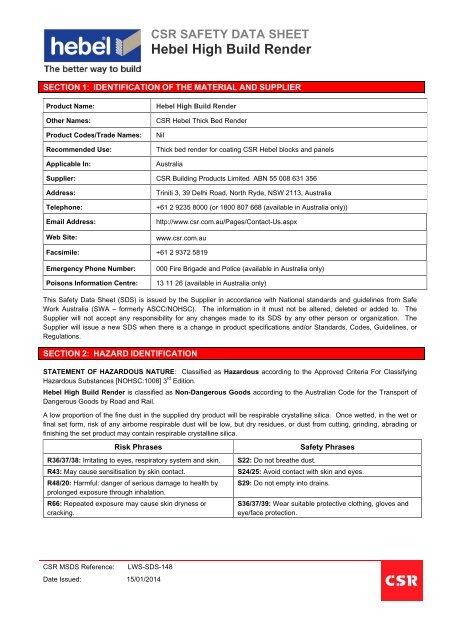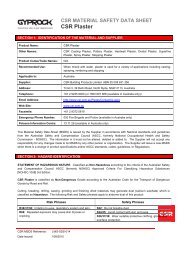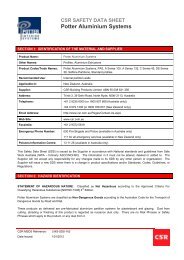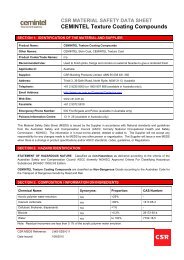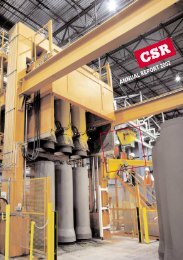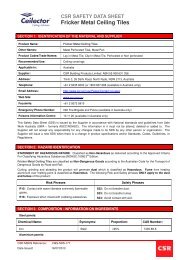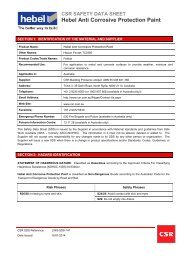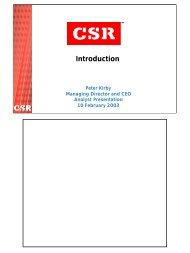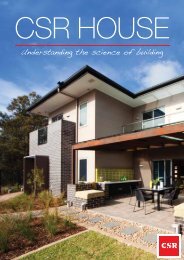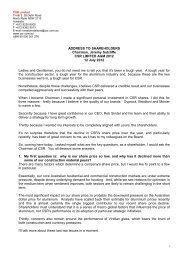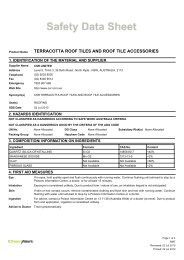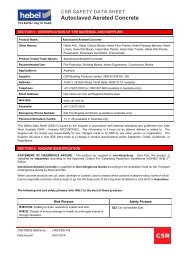Hebel High Build Render MSDS - CSR
Hebel High Build Render MSDS - CSR
Hebel High Build Render MSDS - CSR
Create successful ePaper yourself
Turn your PDF publications into a flip-book with our unique Google optimized e-Paper software.
<strong>CSR</strong> SAFETY DATA SHEET<br />
<strong>Hebel</strong> <strong>High</strong> <strong>Build</strong> <strong>Render</strong><br />
SECTION 1: IDENTIFICATION OF THE MATERIAL AND SUPPLIER<br />
Product Name:<br />
Other Names:<br />
Product Codes/Trade Names:<br />
Recommended Use:<br />
Applicable In:<br />
<strong>Hebel</strong> <strong>High</strong> <strong>Build</strong> <strong>Render</strong><br />
<strong>CSR</strong> <strong>Hebel</strong> Thick Bed <strong>Render</strong><br />
Nil<br />
Thick bed render for coating <strong>CSR</strong> <strong>Hebel</strong> blocks and panels<br />
Australia<br />
Supplier: <strong>CSR</strong> <strong>Build</strong>ing Products Limited ABN 55 008 631 356<br />
Address:<br />
Telephone:<br />
Email Address:<br />
Web Site:<br />
Triniti 3, 39 Delhi Road, North Ryde, NSW 2113, Australia<br />
+61 2 9235 8000 (or 1800 807 668 (available in Australia only))<br />
http://www.csr.com.au/Pages/Contact-Us.aspx<br />
www.csr.com.au<br />
Facsimile: +61 2 9372 5819<br />
Emergency Phone Number:<br />
Poisons Information Centre:<br />
000 Fire Brigade and Police (available in Australia only)<br />
13 11 26 (available in Australia only)<br />
This Safety Data Sheet (SDS) is issued by the Supplier in accordance with National standards and guidelines from Safe<br />
Work Australia (SWA – formerly ASCC/NOHSC). The information in it must not be altered, deleted or added to. The<br />
Supplier will not accept any responsibility for any changes made to its SDS by any other person or organization. The<br />
Supplier will issue a new SDS when there is a change in product specifications and/or Standards, Codes, Guidelines, or<br />
Regulations.<br />
SECTION 2: HAZARD IDENTIFICATION<br />
STATEMENT OF HAZARDOUS NATURE: Classified as Hazardous according to the Approved Criteria For Classifying<br />
Hazardous Substances [NOHSC:1008] 3 rd Edition.<br />
<strong>Hebel</strong> <strong>High</strong> <strong>Build</strong> <strong>Render</strong> is classified as Non-Dangerous Goods according to the Australian Code for the Transport of<br />
Dangerous Goods by Road and Rail.<br />
A low proportion of the fine dust in the supplied dry product will be respirable crystalline silica. Once wetted, in the wet or<br />
final set form, risk of any airborne respirable dust will be low, but dry residues, or dust from cutting, grinding, abrading or<br />
finishing the set product may contain respirable crystalline silica.<br />
Risk Phrases<br />
R36/37/38: Irritating to eyes, respiratory system and skin.<br />
S22: Do not breathe dust.<br />
Safety Phrases<br />
R43: May cause sensitisation by skin contact. S24/25: Avoid contact with skin and eyes.<br />
R48/20: Harmful: danger of serious damage to health by<br />
prolonged exposure through inhalation.<br />
R66: Repeated exposure may cause skin dryness or<br />
cracking.<br />
S29: Do not empty into drains.<br />
S36/37/39: Wear suitable protective clothing, gloves and<br />
eye/face protection.<br />
<strong>CSR</strong> <strong>MSDS</strong> Reference:<br />
LWS-SDS-148<br />
Date Issued: 15/01/2014
SDS for <strong>Hebel</strong> <strong>High</strong> <strong>Build</strong> <strong>Render</strong> Page 2 of 7<br />
SECTION 3: COMPOSITION / INFORMATION ON INGREDIENTS<br />
Chemical Name: Synonyms: Proportion: CAS Number:<br />
Sand containing crystalline silica Quartz > 60% 14808-60-7<br />
Portland Cement 10 – 30% 65997-15-1<br />
Calcium Carbonate 10 – 30% 1317-65-3<br />
Calcium Hydroxide 10 – 30% 1305-62-0<br />
Non hazardous ingredients to 100%<br />
Note: Cement in concrete contains traces (2-20 ppm) of Chromium VI (hexavalent).<br />
SECTION 4: FIRST AID MEASURES<br />
Swallowed:<br />
Eyes:<br />
Skin:<br />
Inhaled:<br />
First Aid Facilities:<br />
Advice to Doctor:<br />
Rinse mouth and lips with water. Do not induce vomiting. Give water to drink to dilute stomach<br />
contents. If symptoms persist, seek medical attention.<br />
Flush thoroughly with flowing water, while holding eyelids open, for 15 minutes to remove all<br />
traces. If symptoms such as irritation or redness persist, seek medical attention. If wet cement<br />
is splashed in the eye, always treat as above, and seek urgent medical attention.<br />
Remove heavily contaminated clothing. Wash off skin thoroughly with water. Use a mild soap if<br />
available. Shower if necessary. Seek medical attention for persistent redness, irritation or<br />
burning of the skin.<br />
Remove to fresh air, away from dusty area. If symptoms persist, seek medical attention.<br />
Eye wash station. Washing facilities with running water.<br />
Treat symptomatically. Wet cement burns to skin or eye may result in corrosive caustic burns.<br />
Ingestion of significant amounts of cement dry or wet is unlikely. Do not induce emesis or<br />
perform gastric lavage. Neutralization with acidic agents is not advised because of increased<br />
risks of exothermic burns. Water-mineral oil soaks may aid in removing hardened cement from<br />
the skin. Ophthalmological opinion should be sought for ocular burns.<br />
SECTION 5: FIRE FIGHTING MEASURES<br />
Flammability:<br />
Suitable extinguishing media:<br />
Hazards from combustion products:<br />
Special protective precautions and<br />
equipment for fire fighters:<br />
HAZCHEM Code:<br />
Non flammable<br />
Use carbon dioxide, foam, dry chemical or water spray as required for fire in<br />
surrounding materials.<br />
None<br />
None<br />
None<br />
SECTION 6: ACCIDENTAL RELEASE MEASURES<br />
Methods and materials for<br />
containment and clean up:<br />
Bag waste materials. Dust is best cleaned up by wet sweeping and/or vacuuming to<br />
avoid making dust airborne. Wetting down before sweeping up dust may be a useful<br />
control measure but will result in setting. Recommendations on Exposure Controls /<br />
<strong>CSR</strong> SDS Reference:<br />
LWS-SDS-148<br />
Date Issued: 15/01/2014
SDS for <strong>Hebel</strong> <strong>High</strong> <strong>Build</strong> <strong>Render</strong> Page 3 of 7<br />
Personal Protection (see Section 8 below) should be followed during spill and clean-up.<br />
Keep product out of storm water and sewer drains.<br />
SECTION 7: HANDLING AND STORAGE<br />
Precautions for safe handling:<br />
Conditions for safe storage:<br />
Incompatibilities:<br />
When supplied in bags these need to be handled in accordance with Manual<br />
Handling Regulations and Code of Practice.<br />
This product should be stored in its factory packaging in a dry area. Protect<br />
from moisture to prevent hardening.<br />
None<br />
SECTION 8: EXPOSURE CONTROLS / PERSONAL PROTECTION<br />
Exposure Standards:<br />
Workplace Exposure Standards for Airborne Contaminants, Safe Work<br />
Australia<br />
Crystalline silica (quartz): TWA – 0.1 mg/m 3 respirable dust (≤ 7 microns<br />
particle equivalent aerodynamic diameter)<br />
Portland cement: TWA – 10 mg/m 3 as inspirable dust<br />
Calcium carbonate: TWA – 10 mg/m 3 as inspirable dust<br />
Calcium hydroxide: TWA – 5 mg/m 3<br />
Total dust (of any type or particle size): TWA – 10 mg/m 3<br />
Notes on Exposure Standards:<br />
All occupational exposures to atmospheric contaminants should be kept to as<br />
low a level as is workable (practicable) and in all cases to below the Workplace<br />
Exposure Standard (WES).<br />
TWA (Time Weighted Average): the time-weighted average airborne<br />
concentration over an eight-hour working day, for a five-day working week over<br />
an entire working life. According to current knowledge this concentration should<br />
neither impair the health of, nor cause undue discomfort to, nearly all workers.<br />
Biological Limit Values:<br />
No biological limit allocated.<br />
ENGINEERING CONTROLS<br />
Ventilation: Work methods and engineering should aim to prevent skin contact with the wet<br />
product. Keep exposures to dust as low as practicable, with the aim of<br />
maintaining respirable crystalline silica dust levels to below the WES. Work in<br />
the open air and external openings (such as doors and windows in buildings)<br />
generally provides adequate ventilation. Local mechanical ventilation or<br />
extraction may be used, if necessary, to control airborne dust levels. Hand tools<br />
generate less dust when cutting, drilling or sanding. If power tools are used they<br />
should be fitted with efficient and well maintained dust extraction devices. If<br />
generated dust cannot be avoided, follow personal protection recommendations.<br />
<br />
Special Consideration for<br />
Repair &/or Maintenance of<br />
Contaminated Equipment:<br />
Where possible vacuum or wash down all gear, equipment or mobile plant prior<br />
to maintenance and repair work. If compressed air cleaning cannot be avoided,<br />
wear eye and respiratory protection and clothing as listed below.<br />
Recommendations on Exposure Control and Personal Protection should be<br />
followed.<br />
<strong>CSR</strong> SDS Reference:<br />
LWS-SDS-148<br />
Date Issued: 15/01/2014
SDS for <strong>Hebel</strong> <strong>High</strong> <strong>Build</strong> <strong>Render</strong> Page 4 of 7<br />
PERSONAL PROTECTION<br />
Personal Hygiene Wash hands before eating, drinking, using the toilet, or smoking. Wash work<br />
clothes regularly.<br />
Skin Protection: Wear loose comfortable clothing. Direct skin contact should be avoided by<br />
wearing long-sleeved shirts and long trousers, a cap or hat, and gloves<br />
(standard duty leather or equivalent AS 2161). Impervious gloves or gauntlets<br />
and footwear are required to protect skin. Never kneel in wet cement, or allow<br />
extended contact of skin with wet cement. Remove clothing which has become<br />
contaminated with wet or dry cement to avoid prolonged contact with the skin. If<br />
cement gets into boots, remove socks and boots immediately and wash skin<br />
thoroughly.<br />
Eye Protection: When working with wet product, splash-resistant safety glasses with side shields<br />
or safety goggles (AS 1336) or a face shield should be worn to ensure all<br />
contact with eyes is avoided. Ventilated non-fogging goggles (dust resistant AS<br />
1336) should be worn when working in a dusty environment.<br />
Respiratory Protection: None required if engineering and handling controls are adequate. Where<br />
engineering and handling controls are not enough to minimise exposure to total<br />
dust and to respirable crystalline silica, personal respiratory protection may be<br />
required. The type of respiratory protection required depends primarily on the<br />
concentration of the respirable crystalline silica dust in the air, and the frequency<br />
and length of exposure time. Amount of exertion required during the work, and<br />
personal comfort are other considerations in choice of respirator. A suitable P1<br />
or P2 particulate respirator chosen and used in accordance with AS 1715 and<br />
1716 may be sufficient for many situations, but where high levels of dust are<br />
encountered, more efficient cartridge-type or powered respirators or supplied-air<br />
helmets or suits may be necessary. Use only respirators that bear the<br />
Australian Standards mark and are fitted and maintained correctly, and kept in<br />
clean storage when not in use.<br />
SECTION 9: PHYSICAL AND CHEMICAL PROPERTIES<br />
Appearance:<br />
Odour:<br />
pH, at stated concentration:<br />
Vapour Pressure:<br />
Vapour Density:<br />
Boiling Point/Range (°C):<br />
Melting Point (°C):<br />
Solubility In Water:<br />
Off-white powder<br />
Cementitious<br />
11-12 (alkaline)<br />
Not applicable<br />
Not applicable<br />
Not applicable<br />
>1200 o C<br />
Slight, reacts on mixing with water forming an alkaline (caustic) solution (pH<br />
>11)<br />
Specific Gravity (H 2 O = 1): 1.55 to 1.65<br />
FLAMMABLE MATERIALS<br />
Flash Point: Not applicable<br />
<strong>CSR</strong> SDS Reference:<br />
LWS-SDS-148<br />
Date Issued: 15/01/2014
SDS for <strong>Hebel</strong> <strong>High</strong> <strong>Build</strong> <strong>Render</strong> Page 5 of 7<br />
Flammable (Explosive) Limits: Not applicable<br />
Auto ignition Temperature: Not applicable<br />
ADDITIONAL PROPERTIES<br />
Evaporation Rate: Not applicable<br />
% Volatiles: 0%<br />
<br />
Volatile Organic Compounds<br />
Content (VOC):<br />
(as specified by the Green <strong>Build</strong>ing<br />
Council of Australia)<br />
None<br />
SECTION 10: STABILITY AND REACTIVITY<br />
Chemical Stability:<br />
Incompatible Materials:<br />
Conditions to avoid:<br />
Hazardous Decomposition Products:<br />
Hazardous Reactions:<br />
Stable<br />
None<br />
Dust generation. Keep free of moisture during storage.<br />
None<br />
None<br />
SECTION 11: TOXICOLOGICAL INFORMATION<br />
Health effects information is based on reported effects in use from overseas and Australian reports.<br />
Health Effects: Acute (short term)<br />
Swallowed:<br />
Eyes:<br />
Skin:<br />
Inhaled:<br />
Unlikely under normal industrial use. Mildly abrasive and corrosive to mouth and throat if<br />
swallowed. May cause nausea, stomach cramps and constipation.<br />
Irritating and corrosive to the eyes and may cause alkaline burns. Dust is irritating to the eyes.<br />
Exposure to dust may aggravate existing eye irritations.<br />
Dust is irritating and drying to the skin. Direct contact with wet product may cause serious skin<br />
burns. Within 12 to 48 hours (after one to six-hour exposures) possible first, second or third<br />
degree burns may occur. There may be no obvious pain at the time of the exposure. Chronic<br />
skin disorders may be aggravated by exposure to dust or contact with wet product due to<br />
presence of Portland Cement.<br />
Dust is irritating to the nose, throat and respiratory tract causing coughing and sneezing. Preexisting<br />
upper respiratory and lung diseases including asthma and bronchitis may be<br />
aggravated.<br />
Health Effects: Chronic (long term)<br />
Eyes:<br />
Skin:<br />
Dust may cause irritation and inflammation of the eyes and aggravate pre-existing eye<br />
conditions.<br />
Repeated heavy contact with the dust may cause drying of the skin and can result in skin rash<br />
(dermatitis) typically affecting the hands. Over time this may become chronic and can also<br />
become infected. Persons who are allergic to chromium may develop an allergic dermatitis<br />
which aggravates the irritant effects and this combination can lead to chronic cement dermatitis<br />
and serious disability particularly affecting the hands.<br />
<strong>CSR</strong> SDS Reference:<br />
LWS-SDS-148<br />
Date Issued: 15/01/2014
SDS for <strong>Hebel</strong> <strong>High</strong> <strong>Build</strong> <strong>Render</strong> Page 6 of 7<br />
Inhaled:<br />
Additional Notes<br />
Long Term Effects:<br />
Repeated exposure to the dust may result in increased nasal and respiratory secretions and<br />
coughing. Inflammation of lining tissue of the respiratory system may follow repeated exposure<br />
to high levels of dust with increased risk of bronchitis and pneumonia.<br />
Long term occupational over-exposure or prolonged breathing-in (or inhalation) of crystalline<br />
silica dust at levels above the NES carries the risk of causing serious and irreversible lung<br />
disease, including bronchitis, and silicosis (scarring of the lung), including acute and/or<br />
accelerated silicosis. It may also increase the risk of other irreversible and serious disorders<br />
including scleroderma (a disease affecting the skin, joints, blood vessels and internal organs)<br />
and other auto-immune disorders.<br />
SWA has not classified crystalline silica as a carcinogen.<br />
Special Toxic<br />
Effects:<br />
Inhalation of dust, including crystalline silica dust, is considered by medical authorities to<br />
increase the risk of lung disease due to tobacco smoking.<br />
SECTION 12: ECOLOGICAL INFORMATION<br />
Eco-toxicity:<br />
Persistence and<br />
Degradability:<br />
Mobility:<br />
Product forms an alkaline slurry when mixed with water.<br />
Product is persistent and would have a low degradability.<br />
A low mobility would be expected in a landfill situation.<br />
SECTION 13: DISPOSAL CONSIDERATIONS<br />
<strong>Hebel</strong> <strong>High</strong> <strong>Build</strong> <strong>Render</strong> can be treated as a common waste for disposal or dumped into a landfill site in accordance<br />
with local authority guidelines. Keep material out of storm water and sewer drains.<br />
Measures should be taken to prevent dust generation during disposal and exposure and personal precautions should be<br />
observed (see Section 8 above).<br />
SECTION 14: TRANSPORT INFORMATION<br />
UN number:<br />
UN Proper Shipping Name:<br />
Class and Subsidiary Risk :<br />
Packaging Group:<br />
Special Precautions for User:<br />
HAZCHEM code:<br />
None allocated<br />
None allocated<br />
None allocated<br />
None allocated<br />
None<br />
None allocated<br />
SECTION 15: REGULATORY INFORMATION<br />
Poisons Schedule:<br />
Not Scheduled<br />
Exposures by inhalation to high levels of dust may be regulated under the Hazardous Substances Regulations (State) as<br />
they are applicable to Respirable Crystalline Silica, requiring exposure assessment, controls and health surveillance<br />
(ASCC/NOHSC).<br />
<strong>CSR</strong> SDS Reference:<br />
LWS-SDS-148<br />
Date Issued: 15/01/2014
SDS for <strong>Hebel</strong> <strong>High</strong> <strong>Build</strong> <strong>Render</strong> Page 7 of 7<br />
SECTION 16: OTHER INFORMATION<br />
For further information on this product, please contact:<br />
<strong>CSR</strong> <strong>Build</strong>ing Products Limited (ABN 55 008 631 356), Triniti 3, 39 Delhi Road, North Ryde, NSW 2113, Australia.<br />
Phone: +61 2 9372 5888 or 1800 807 668 (available in Australia only)<br />
Fax: +61 2 9372 5877<br />
ADDITIONAL INFORMATION<br />
Australian Standards References:<br />
AS 1336<br />
Recommended Practices for Occupational Eye Protection<br />
AS 1715<br />
AS 1716<br />
AS 2161<br />
Other References:<br />
NOHSC:1008 (2004)<br />
NOHSC:10005<br />
(1999)<br />
NOHSC:2007 (1994)<br />
Model Code of<br />
Practice<br />
Model Code of<br />
Practice<br />
WES<br />
ADG Code<br />
GHS<br />
Selection, Use and Maintenance of Respiratory Protective Devices<br />
Respiratory Protective Devices<br />
Industrial Safety Gloves and Mittens (excluding electrical and medical gloves)<br />
Approved Criteria for Classifying Hazardous Substances<br />
List Of Designated Hazardous Substances, April 1999, National Occupational Health and Safety<br />
Commission, Sydney.<br />
National Code of Practice for the Control of Workplace Hazardous Substances (Australian<br />
States have similar Codes of Practice in each State).<br />
Preparation of Safety Data Sheets for Hazardous Chemicals, December 2011, Safe Work<br />
Australia.<br />
Labelling of Workplace Hazardous Chemicals, December 2011, Safe Work Australia.<br />
Workplace Exposure Standards for Airborne Contaminants, December 2011, Safe Work<br />
Australia.<br />
Australian Code for the Transport of Dangerous Goods by Road and Rail, 7 th edition, National<br />
Transport Commission.<br />
Globally Harmonized System of Classification and Labelling of Chemicals (GHS), 3 rd revised<br />
edition, United Nations, New York and Geneva, 2009.<br />
AUTHORISATION<br />
Reason for Issue:<br />
Authorised by:<br />
5-yearly review and update<br />
Marketing Manager<br />
Date of Issue: 15/01/2014<br />
Whilst the information contained in this document is based on data which, to the best of our knowledge, was accurate and<br />
reliable at the time of preparation, no responsibility can be accepted by us for errors and omissions. The provision of this<br />
information should not be construed as a recommendation to use any of our products in violation of any patent rights or in<br />
breach of any statute or regulation. Users are advised to make their own determination as to the suitability of this<br />
information in relation to their particular purposes and specific circumstances. Since the information contained in this<br />
document may be applied under conditions beyond our control, no responsibility can be accepted by us for any loss or<br />
damage caused by any person acting or refraining from action as a result of this information.<br />
END OF SDS<br />
<strong>CSR</strong> SDS Reference:<br />
LWS-SDS-148<br />
Date Issued: 15/01/2014


